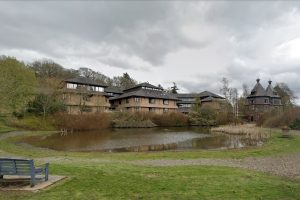FUNDING for the second phase of a pioneering project encouraging the use of Welsh timber in the construction industry is needed to encourage more low carbon homes in Wales, according to a Mid Wales architect.
The first phase of Home-Grown Wales, a project set up in 2018 to test and identify interventions in the Welsh timber construction supply chain and encourage the delivery of low carbon social housing in Wales, came to an end in December 2020.
Doug Hughes, Principal Architect and Managing Director of building design and planning practice Hughes Architects, said it was important for the second phase to be given the green light by the Welsh Government.
Home-Grown Wales, led by Powys County and funded by the Welsh Government and the EU Rural Development Programme, has spearheaded the use of Welsh timber in public and private sector housing projects in addition to formulating policy on and leading to construction of low carbon social housing.
The research project was delivered by WoodknowledgeWales with project partners Cardiff Metropolitan University, Coed Cymru and BM TRADA.
“The first phase of Home-Grown Wales has not only made great strides in influencing the construction industry to use more Welsh timber, but it has also helped support many small and medium-sized business in rural Wales involved in the supply chain,” said Mr Hughes.
“The economic impact is supporting jobs, businesses and communities, in rural Wales in addition to the environmental benefits. Housing associations, local authorities and private housebuilders have all been influenced.
“It’s created a truly sustainable way of supporting the economy of rural Wales while encouraging the construction of low carbon social housing, such as the first Passivhaus scheme at Sarn, near Newtown by Powys County Council which we were proud to have designed.”
Mr Hughes, who is a director of WoodKnowledgeWales, said the Welsh Government should confirm funding for the second phase of the project.
“The first phase was the foundation. We now need to build on this to ensure we don’t lose impetus. The second phase will look at additional opportunities in the use of Welsh timber in the supply chain for products such as windows and wood fibre insulation,” he said.
“As architects we have been working towards creating more and more carbon neutral buildings. In addition to Welsh timber there are other natural materials, such as wool, that can also be incorporated into the construction industry.”
He added: “Home-Grown Wales is creating much wider economic benefits for our rural communities than might be first thought. If we can develop the project further, we could see the creation of more employment benefits while reducing the carbon footprint of homes.”
The Welsh Government is understood to be considering funding for the second phase. Mr Hughes said he hope Ministers would realise the social, economic, and environmental benefits of the project.
He added: “We are at the beginning of something very exciting. We need to ensure we build on this for the benefit of our rural communities and the environment.”
Powys County Council’s Cabinet was due to discuss the first phase of the project at a meeting on Wednesday, June 16 2021.


















Add Comment